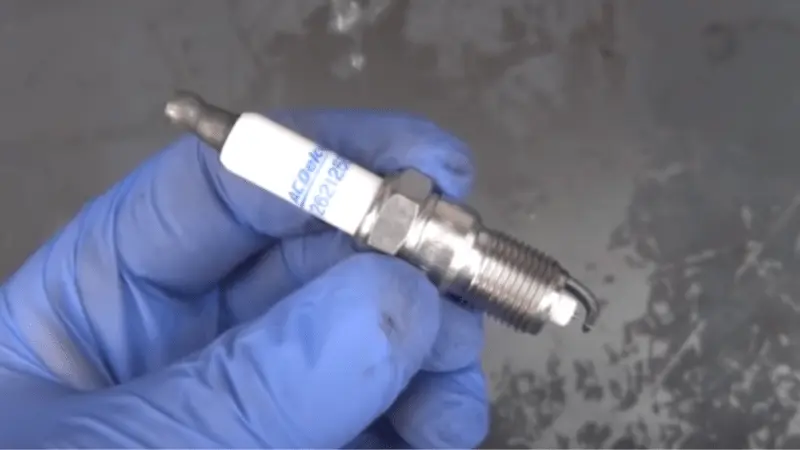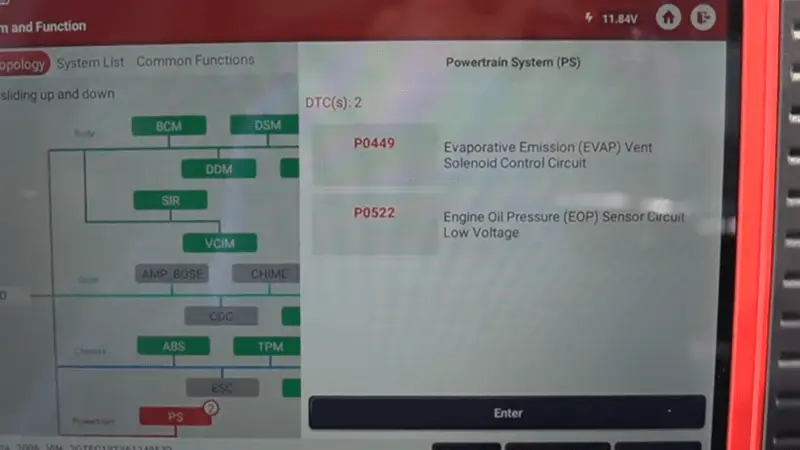The sudden appearance of a flashing check engine light in your GMC Sierra can be a cause for concern, signaling potential issues that demand immediate attention. However, when the light stops flashing, it doesn’t necessarily mean the problem has vanished. But why does the “GMC Sierra Check Engine Light Flashing Then Stops” issue arise?
The issue may arise due to severe engine or emission system problems. Flashing indicates critical issues demanding immediate attention, often caused by factors like faulty sensors, ignition system problems, or emissions issues. Diagnosing and resolving these root causes is essential for restoring optimal vehicle performance and avoiding potential damage.
Join us as we unravel the mysteries behind this enigmatic warning signal and empower you with insights on how to address and resolve this critical issue.
What Does The Check Engine Light Mean?

The check engine light in GMC Sierras is a crucial part of the onboard diagnostics system, often appearing as a “Check Engine” or an engine icon. This amber or red light signifies the vehicle’s diagnostics system, which has been regulating and monitoring performance since the 1980s. The system controls critical tasks such as engine speed, automatic transmission ignition timing, and stability control. The check engine light can indicate various issues, ranging from a loose gas cap to more serious engine concerns. If you encounter a check engine light flickering or need assistance decoding the associated code, contacting Coggin Buick/GMC of Orange Park is recommended. Our skilled GMC repair staff can analyze and address the issues triggering the check engine light. Call Orange Park’s Coggin Buick/GMC for prompt assistance.
Reasons For GMC Sierra Check Engine Light Flashing then Stops

The GMC Sierra’s check engine light serves as a crucial indicator, offering insights into potential issues that range from minor to severe. Understanding the reasons behind a flashing check engine light, followed by its cessation, can help address underlying problems. Here are eight possible causes:
1. Gas Cap Issues:
A loose, broken, or missing gas cap can lead to fuel system problems, triggering the check engine light. The gas cap serves a crucial role in maintaining fuel tank pressure and preventing harmful emissions. If the cap is faulty, evaporation issues can occur, impacting fuel efficiency and causing repeated trips to the gas pump. Fortunately, resolving this issue is relatively simple and cost-effective—ensuring the cap is securely tightened or replacing it can eliminate the check engine light.
2. Aftermarket Equipment Problems:
Aftermarket additions, like alarms or exhaust systems, may cause issues if improperly installed. These additions can deplete the battery, activate the check engine light, or even prevent the vehicle from starting. Professional inspection by certified technicians is recommended to assess the installation and functionality of aftermarket items. While aftermarket accessories may incur additional costs, they can save owners from potential complications resulting from poorly executed installations.
3. Spark Plugs or Wires Need Replacement:

Outdated or damaged spark plugs and wires can significantly impact engine performance. Spark plugs play a crucial role in igniting the air/fuel mixture in the combustion chamber, driving piston movement. Worn-out components can lead to poor performance, reduced power, and, in severe cases, engine starting issues. Additionally, neglected spark plugs and wires can contribute to blockages in the catalytic converter, ignition coils, and O2 sensors, necessitating more extensive and costly repairs.
4. Low or Dead Battery:
A functioning battery is vital for various vehicle operations. Without it, the car won’t start, headlights won’t illuminate, the radio won’t play, and even phone charging becomes impossible. Modern car batteries generally require minimal maintenance, but when they fail, replacement is necessary. The cost of a new battery varies depending on the GMC Sierra model, making regular battery checks and replacements an essential aspect of vehicle maintenance.
5. Faulty Catalytic Converter:
The catalytic converter is a critical component of the exhaust system in the GMC Sierra. It converts harmful carbon monoxide into carbon dioxide, contributing to emission control. Regular maintenance, including a free multi-point inspection, can detect early signs of catalytic converter damage. A damaged converter can lead to failed emissions tests, reduced engine performance, increased vehicle temperatures, and potential safety issues, necessitating timely repairs.
6. Vacuum Leaks:
The vacuum system in the GMC Sierra plays multiple roles in emission control. A vacuum leak can result in irregular surges or excessive idle RPM. Severe weather conditions may cause vacuum hoses to dry up and split, compromising the proper functioning of the system. A professional inspection is recommended to identify and address vacuum leaks, ensuring optimal engine performance and emission control.
7. Mass Airflow Sensor (MAF) Replacement:
The MAF sensor is crucial for measuring engine airflow and adjusting to altitude changes. A defective MAF sensor can lead to various issues, including difficulties starting the engine, poor idling, and sudden changes in throttle pedal position. Given its role in engine management, timely replacement of a faulty MAF sensor is essential to maintain smooth operation and fuel efficiency.
8. Oxygen (O2) Sensor Replacement:
Oxygen sensors monitor the oxygen levels in the exhaust system, influencing the air-fuel mixture for engine cylinders. A malfunctioning O2 sensor can result in increased oxygen levels, leading to faster fuel burning and decreased fuel efficiency. Ignoring O2 sensor issues can have cascading effects, causing harm to spark plugs, catalytic converters, and overall MPG. Regular sensor updates ensure accurate data transmission to the vehicle’s onboard computer, preventing emission test failures and maintaining optimal engine performance.
How To Fix The “GMC Sierra Check Engine Light Flashing Then Stops” Issue?
Experiencing a flashing check engine light in your GMC Sierra can be alarming, indicating a severe issue that demands immediate attention. If the light stops flashing, it doesn’t mean the problem is resolved; rather, it may indicate a momentary improvement or stabilization. Here’s a guide on how to address the “GMC Sierra Check Engine Light Flashing Then Stops” issue:
1.Pull Over Safely:
If your GMC Sierra’s check engine light is flashing, it signals a critical problem with the engine or emission system. Immediately pull over to a safe location, turn off the engine, and assess the situation.
2. Check Gas Cap:
Start with the basics. A loose, damaged, or missing gas cap can trigger the check engine light. Ensure the gas cap is secure and undamaged. If it shows signs of wear or damage, consider replacing it.
3. Inspect for Visible Issues:
Conduct a visual inspection under the hood for any visible issues, such as disconnected or damaged hoses, wires, or components. Addressing visible problems can sometimes resolve the check engine light issue.
4. Diagnose with OBD-II Scanner:
Invest in an OBD-II scanner, a tool that allows you to retrieve diagnostic trouble codes (DTCs) from your vehicle’s computer. These codes provide insights into the specific issue triggering the check engine light. Professional auto parts stores may also perform code readings for free.
5. Interpret Diagnostic Codes:
Once you have the DTCs, research and interpret them using reliable sources or seek assistance from a professional. These codes will guide you toward understanding the root cause of the check engine light.
6. Address the Underlying Issue:
Depending on the diagnostic codes, you may need to address issues such as faulty sensors, ignition system problems, or emissions-related issues. Follow manufacturer guidelines and recommendations for resolving specific DTCs.
7. Perform Necessary Repairs:
Based on the identified issue, perform the necessary repairs. This may involve replacing sensors, fixing wiring problems, or addressing issues with the ignition or emission systems. If you need more confidence in your ability to make repairs, seek professional assistance.
8. Clear Diagnostic Codes:

After making repairs, use the OBD-II scanner to clear the diagnostic trouble codes. This step resets the check engine light. Ensure that the issue has been adequately addressed before clearing the codes.
RELATED: GMC Sierra Ticking Noise When Accelerating
FAQs
1. Why Does The Check Engine Light Flash In My GMC Sierra?
The flashing check engine light signals a severe issue, often related to the engine or emission system. Common triggers include faulty sensors, ignition problems, or emissions issues.
2. Can I Continue Driving If The Check Engine Light Stops Flashing?
While the flashing may cease, it doesn’t signify resolution. Continuing to drive without addressing the underlying problem poses risks. Prompt diagnostics and repairs are advised.
3. How Can I Interpret Diagnostic Trouble Codes (DTCs)?
Use an OBD-II scanner to retrieve DTCs, then refer to reliable sources or consult professionals for code interpretation to understand the specific issue triggering the check engine light.
4. Are Loose Gas Caps A Common Cause Of Check Engine Light Issues?
Yes, a loose, damaged, or missing gas cap is a common culprit. Ensuring the gas cap is secure and replacing it if necessary can resolve the issue.
5. What Role Does Regular Maintenance Play In Preventing Check Engine Light Problems?
Regular maintenance, including component checks and replacements, is crucial for preventing recurring check engine light issues. Timely attention to spark plugs, filters, and sensors helps maintain optimal engine performance.
Final Words:
Understanding and addressing the “GMC Sierra Check Engine Light Flashing Then Stops” issue is paramount for vehicle owners. Swift diagnostics, interpretation of codes, and proactive maintenance are key. Whether tackling simple gas cap issues or complex sensor malfunctions, staying informed ensures the longevity and optimal performance of your GMC Sierra. Always prioritize timely repairs and professional assistance to keep your vehicle running smoothly on the road.

Eric L. Friedman is a car expert who has worked on Chevy and GMC trucks for over 10 years. He started AutoYolo to help people fix their own cars. On the blog, he shares easy tips, step-by-step guides, and repair advice to make car problems less stressful and more affordable.

